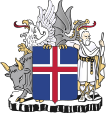| |||||||||||||||||||||||||||||||||||||||||||||||||||||||||||||||||||||||
All 35 seats in the Lower House and 17 seats in the Upper House of Althing | |||||||||||||||||||||||||||||||||||||||||||||||||||||||||||||||||||||||
| Turnout | 89.03% | ||||||||||||||||||||||||||||||||||||||||||||||||||||||||||||||||||||||
|---|---|---|---|---|---|---|---|---|---|---|---|---|---|---|---|---|---|---|---|---|---|---|---|---|---|---|---|---|---|---|---|---|---|---|---|---|---|---|---|---|---|---|---|---|---|---|---|---|---|---|---|---|---|---|---|---|---|---|---|---|---|---|---|---|---|---|---|---|---|---|---|
| |||||||||||||||||||||||||||||||||||||||||||||||||||||||||||||||||||||||
| Politics of Iceland |
|---|
 |
|
Government
|
|
Legislature
|
|
Executive |
| Judiciary |
|
Elections
|
| Political parties |
| Administrative divisions |
| Foreign relations |
|
|
Parliamentary elections were held in Iceland on 23 and 24 October 1949. The Independence Party remained the largest party in the Lower House of the Althing, winning 13 of the 35 seats.
Electoral system
The elections were conducted under rural–urban proportional representation. Twenty-one members were elected in single-member constituencies via first-past-the-post voting, while the remainder were elected using D'Hondt method proportional representation: twelve members in two-member constituencies, eight members in Reykjavík, and eleven from a single national compensatory list. To earn national list seats, a party had to win at least one constituency seat. In constituencies electing two or more members, within the party list, voters had the option to re-rank the candidates and could also strike a candidate out. Allocation of seats to candidates was done using a system based on the Borda count.
Results
| Party | Votes | % | Seats | |||||
|---|---|---|---|---|---|---|---|---|
| Lower House | +/– | Upper House | +/– | |||||
| Independence Party | 28,546 | 39.53 | 13 | 0 | 6 | –1 | ||
| Progressive Party | 17,659 | 24.45 | 11 | +2 | 6 | +2 | ||
| People's Unity Party – Socialist Party | 14,077 | 19.49 | 6 | –1 | 3 | 0 | ||
| Social Democratic Party | 11,937 | 16.53 | 5 | –1 | 2 | –1 | ||
| Total | 72,219 | 100.00 | 35 | 0 | 17 | 0 | ||
| Valid votes | 72,219 | 98.35 | ||||||
| Invalid/blank votes | 1,213 | 1.65 | ||||||
| Total votes | 73,432 | 100.00 | ||||||
| Registered voters/turnout | 82,481 | 89.03 | ||||||
| Source: Nohlen & Stöver | ||||||||
References
- Dieter Nohlen & Philip Stöver (2010) Elections in Europe: A data handbook, p961 ISBN 978-3-8329-5609-7
- Nohlen & Stöver, p975
- Renwick, Alan (2010). Helgason, Þorkell; Hermundardóttir, Friðný Ósk; Simonarson, Baldur (eds.). "Electoral System Change in Europe since 1945: Iceland" (PDF). Electoral system change since 1945. Archived (PDF) from the original on 4 October 2021. Retrieved 4 October 2021.
| Parliamentary elections |
|
|---|---|
| Presidential elections | |
| Municipal elections | |
| Referendums | |
| Constitutional Assembly | |
This Icelandic elections-related article is a stub. You can help Misplaced Pages by expanding it. |